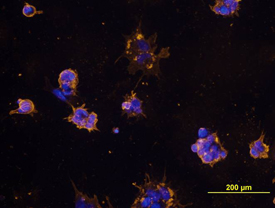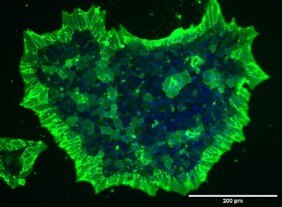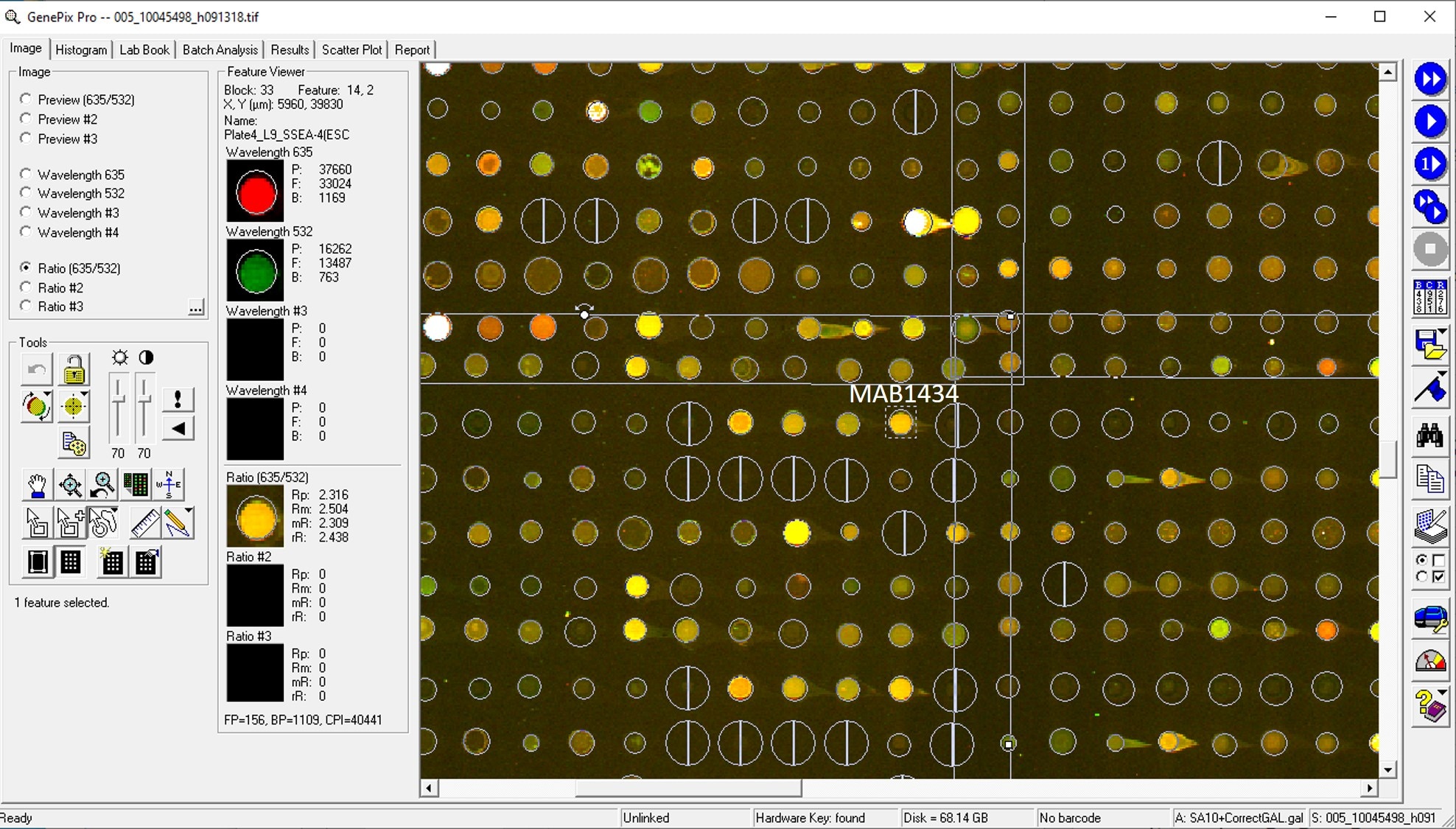Human/Mouse SSEA-3 Antibody Summary
Applications
Please Note: Optimal dilutions should be determined by each laboratory for each application. General Protocols are available in the Technical Information section on our website.
Scientific Data
 View Larger
View Larger
SSEA‑3 in BG01V Human Stem Cells. SSEA-3 was detected in immersion fixed non-permeabilized BG01V human embryonic stem cells using Human/Mouse SSEA-3 Monoclonal Antibody (Catalog # MAB1434) at 10 µg/mL for 3 hours at room temperature. Cells were stained using the NorthernLights™ 557-conjugated Anti-Rat IgG Secondary Antibody (yellow; Catalog # NL013) and counterstained with DAPI (blue). View our protocol for Fluorescent ICC Staining of Cells on Coverslips.
Reconstitution Calculator
Preparation and Storage
- 12 months from date of receipt, -20 to -70 °C as supplied.
- 1 month, 2 to 8 °C under sterile conditions after reconstitution.
- 6 months, -20 to -70 °C under sterile conditions after reconstitution.
Background: SSEA-3
SSEA-3, also known as glycolipid GB5, is expressed on the surface of human teratocarcinoma stem cells (EC), human embryonic germ cells (EG), and human embryonic stem cells (ES) (1). Expression of SSEA-3 is down regulated following differentiation of human EC cells. In contrast, the differentiation of murine EC and ES cells may be accompanied by an increase in SSEA-3 expression (2, 3).
-
Zhou, D. et al. (2000) J. Biol. Chem. 275:22631.
-
Thomson, J.A. and J.S. Odorico (2000) Trends Biotechnol. 18:53.
-
Draper, J.S. et al. (2002) J. Anat. 200:249.
-
Shevinsky, L.H. et al. (1982) Cell 30:697.
- Kannagi, R. et al. (1983) EMBO J. 2:2355.
Product Datasheets
Citations for Human/Mouse SSEA-3 Antibody
R&D Systems personnel manually curate a database that contains references using R&D Systems products. The data collected includes not only links to publications in PubMed, but also provides information about sample types, species, and experimental conditions.
19
Citations: Showing 1 - 10
Filter your results:
Filter by:
-
Definition of germ layer cell lineage alternative splicing programs reveals a critical role for Quaking in specifying cardiac cell fate
Authors: WS Fagg, N Liu, U Braunschwe, KL Pereira de, X Chen, FS Ditmars, SG Widen, JP Donohue, K Modis, WK Russell, JH Fair, MT Weirauch, BJ Blencowe, MA Garcia-Bla
Nucleic Acids Research, 2022-05-20;50(9):5313-5334.
Species: Human
Sample Types: Whole Cells
Applications: ICC -
Induced pluripotent stem cells from subjects with Lesch-Nyhan disease
Authors: DJ Sutcliffe, AR Dinasarapu, JE Visser, JD Hoed, F Seifar, P Joshi, I Ceballos-P, T Sardar, EJ Hess, YV Sun, Z Wen, ME Zwick, HA Jinnah
Scientific Reports, 2021-04-19;11(1):8523.
Species: Human
Sample Types: Whole Cells
Applications: ICC -
Endoderm and Hepatic Progenitor Cells Engraft in the Quiescent Liver Concurrent with Intrinsically Activated Epithelial-to-Mesenchymal Transition
Authors: WS Fagg, N Liu, I Patrikeev, OA Saldarriag, M Motamedi, VL Popov, HL Stevenson, JH Fair
Cell Transplantation, 2021-01-01;30(0):9636897219937.
Species: Human
Sample Types: Whole Cells
Applications: ICC -
Effects of the Extracts from Fruit and Stem of Camellia japonica on Induced Pluripotency and Wound Healing
Authors: H Jeon, JY Kim, JK Choi, E Han, CL Song, J Lee, YS Cho
J Clin Med, 2018-11-20;7(11):.
Species: Human
Sample Types: Whole Cells
Applications: Flow Cytometry -
Progesterone Receptor Membrane Component 1 suppresses the p53 and Wnt/?-catenin pathways to promote human pluripotent stem cell self-renewal
Authors: JY Kim, SY Kim, HS Choi, MK Kim, HM Lee, YJ Jang, CJ Ryu
Sci Rep, 2018-02-14;8(1):3048.
Species: Human
Sample Types: Whole Cells
Applications: Flow Cytometry -
High expression FUT1 and B3GALT5 is an independent predictor of postoperative recurrence and survival in hepatocellular carcinoma
Authors: HH Kuo, RJ Lin, JT Hung, CB Hsieh, TH Hung, FY Lo, MY Ho, CT Yeh, YL Huang, J Yu, AL Yu
Sci Rep, 2017-09-07;7(1):10750.
Species: Human
Sample Types: Whole Tissue
Applications: IHC -
Induction of Pluripotent Stem Cells from a Manifesting Carrier of Duchenne Muscular Dystrophy and Characterization of Their X-Inactivation Status
Authors: Y Miyagoe-Su, T Nishiyama, M Nakamura, A Narita, F Takemura, S Masuda, N Minami, K Murayama, H Komaki, YI Goto, S Takeda
Stem Cells Int, 2017-04-12;2017(0):7906843.
Species: Human
Sample Types: Whole Cells
Applications: ICC -
Rapid establishment of the European Bank for induced Pluripotent Stem Cells (EBiSC) - the Hot Start experience
Authors: PA De Sousa, R Steeg, E Wachter, K Bruce, J King, M Hoeve, S Khadun, G McConnachi, J Holder, A Kurtz, S Seltmann, J Dewender, S Reimann, G Stacey, O O'Shea, C Chapman, L Healy, H Zimmermann, B Bolton, T Rawat, I Atkin, A Veiga, B Kuebler, BM Serano, T Saric, J Hescheler, O Brüstle, M Peitz, C Thiele, N Geijsen, B Holst, C Clausen, M Lako, L Armstrong, SK Gupta, AJ Kvist, R Hicks, A Jonebring, G Brolén, A Ebneth, A Cabrera-So, P Foerch, M Geraerts, TC Stummann, S Harmon, C George, I Streeter, L Clarke, H Parkinson, PW Harrison, A Faulconbri, L Cherubin, T Burdett, C Trigueros, MJ Patel, C Lucas, B Hardy, R Predan, J Dokler, M Brajnik, O Keminer, O Pless, P Gribbon, C Claussen, A Ringwald, B Kreisel, A Courtney, TE Allsopp
Stem Cell Res, 2017-03-07;20(0):105-114.
Species: Human
Sample Types: Whole Cells
Applications: Flow Cytometry -
Microfabric Vessels for Embryoid Body Formation and Rapid Differentiation of Pluripotent Stem Cells
Sci Rep, 2016-08-10;6(0):31063.
Species: Human
Sample Types: Whole Cells
Applications: IHC -
A Cytotoxic Antibody Recognizing Lacto-N-fucopentaose I (LNFP I) on Human Induced Pluripotent Stem (hiPS) Cells.
Authors: Matsumoto S, Nakao H, Kawabe K, Nonaka M, Toyoda H, Takishima Y, Kawabata K, Yamaguchi T, Furue M, Taki T, Okumura T, Yamazaki Y, Nakaya S, Kawasaki N, Kawasaki T
J Biol Chem, 2015-06-22;290(33):20071-85.
Species: Human
Sample Types: Whole Cells
Applications: IHC -
B-cell receptor-associated protein 31 regulates human embryonic stem cell adhesion, stemness, and survival via control of epithelial cell adhesion molecule.
Authors: Kim W, Seo Choi H, Min Lee H, Jang Y, Ryu C
Stem Cells, 2014-10-01;32(10):2626-41.
Species: Human
Sample Types: Whole Cells
Applications: Flow Cytometry -
Comparison of bone marrow and adipose tissue-derived canine mesenchymal stem cells.
BMC Vet Res, 2012-08-31;8(0):150.
Species: Canine
Sample Types: Whole Cells
Applications: Flow Cytometry -
Multipotent mesenchymal stem cells from human placenta: critical parameters for isolation and maintenance of stemness after isolation.
Authors: Semenov O, Koestenbauer S, Riegel M, Zech N, Zimmermann R, Zisch A, Malek A
Am J Obstet Gynecol, 2009-12-24;202(2):193.e1-193.e1.
Species: Human
Sample Types: Whole Cells, Whole Tissue
Applications: Flow Cytometry, IHC -
Histone deacetylase inhibition elicits an evolutionarily conserved self-renewal program in embryonic stem cells.
Authors: Ware CB, Wang L, Mecham BH, Shen L, Nelson AM, Bar M, Lamba DA, Dauphin DS, Buckingham B, Askari B, Lim R, Tewari M, Gartler SM, Issa JP, Pavlidis P, Duan Z, Blau CA
Cell Stem Cell, 2009-04-03;4(4):359-69.
Species: Mouse
Sample Types: Whole Cells
Applications: Flow Cytometry -
Generation of pluripotent stem cells from adult human testis.
Authors: Conrad S, Renninger M, Hennenlotter J, Wiesner T, Just L, Bonin M, Aicher W, Buhring HJ, Mattheus U, Mack A, Wagner HJ, Minger S, Matzkies M, Reppel M, Hescheler J, Sievert KD, Stenzl A, Skutella T
Nature, 2008-10-08;456(7220):344-9.
Species: Human
Sample Types: Whole Cells
Applications: Flow Cytometry -
Secreted proteoglycans directly mediate human embryonic stem cell-basic fibroblast growth factor 2 interactions critical for proliferation.
Authors: Levenstein ME, Berggren WT, Lee JE, Conard KR, Llanas RA, Wagner RJ, Smith LM, Thomson JA
Stem Cells, 2008-09-18;26(12):3099-107.
Species: Human
Sample Types: Whole Cells
Applications: ICC -
Equine umbilical cord blood contains a population of stem cells that express Oct4 and differentiate into mesodermal and endodermal cell types.
Authors: Reed SA, Johnson SE
J. Cell. Physiol., 2008-05-01;215(2):329-36.
Species: Equine
Sample Types: Whole Cells
Applications: ICC -
Regulation of self-renewal and pluripotency by Sox2 in human embryonic stem cells.
Authors: Fong H, Hohenstein KA, Donovan PJ
Stem Cells, 2008-04-03;26(8):1931-8.
Species: Human
Sample Types: Whole Cells
Applications: ICC -
Nucleofection mediates high-efficiency stable gene knockdown and transgene expression in human embryonic stem cells.
Authors: Hohenstein KA, Pyle AD, Chern JY, Lock LF, Donovan PJ
Stem Cells, 2008-03-06;26(6):1436-43.
Species: Human
Sample Types: Whole Cells
Applications: ICC
FAQs
No product specific FAQs exist for this product, however you may
View all Antibody FAQsReviews for Human/Mouse SSEA-3 Antibody
Average Rating: 4 (Based on 5 Reviews)
Have you used Human/Mouse SSEA-3 Antibody?
Submit a review and receive an Amazon gift card.
$25/€18/£15/$25CAN/¥75 Yuan/¥2500 Yen for a review with an image
$10/€7/£6/$10 CAD/¥70 Yuan/¥1110 Yen for a review without an image
Filter by:
I used it to check for SSEA-3 in my iPSCs- beautiful staining



